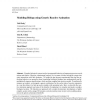Free Online Productivity Tools
i2Speak
i2Symbol
i2OCR
iTex2Img
iWeb2Print
iWeb2Shot
i2Type
iPdf2Split
iPdf2Merge
i2Bopomofo
i2Arabic
i2Style
i2Image
i2PDF
iLatex2Rtf
Sci2ools
FUIN
2010
2010
Modeling Biology using Generic Reactive Animation
Abstract. Complex biological systems involve incorporated behaviors of numerous processes, mechanisms and objects. However, experimental analysis, by its nature, divides biological systems into static interactions with little dynamics. To bridge the gap between experimental data and the underlying behavior, our group has been formalizing biological findings into mathematically and algorithmically rigorous specifications, which are then compiled into reactive models. To realistically animate our models, we designed a generic architecture for the earlier idea of reactive animation, in a way that allows it to link up reactive models with animation tools. Here, we describe the reactive animation approach and some of the benefits of employing it to simulate and analyze complex biological systems. We illustrate our approach with a model of pancreatic development, a highly complex system with a unique 3D structure, and also mention more recent work on adding animation to the generic cell proj...
Related Content
| Added | 02 Mar 2011 |
| Updated | 02 Mar 2011 |
| Type | Journal |
| Year | 2010 |
| Where | FUIN |
| Authors | Yaki Setty, Irun R. Cohen, David Harel |
Comments (0)

